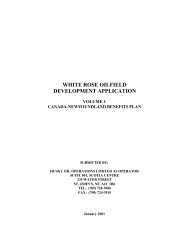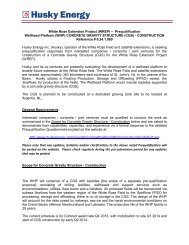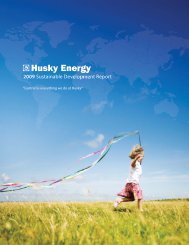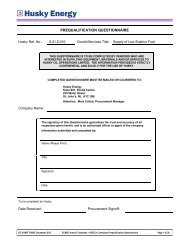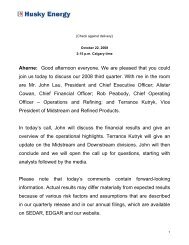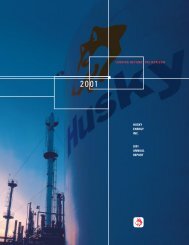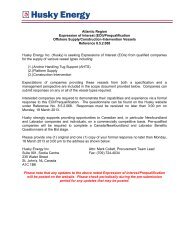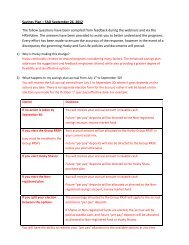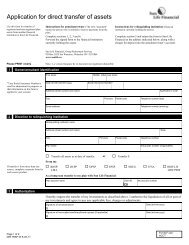white rose oilfield development application - Husky Energy
white rose oilfield development application - Husky Energy
white rose oilfield development application - Husky Energy
- No tags were found...
You also want an ePaper? Increase the reach of your titles
YUMPU automatically turns print PDFs into web optimized ePapers that Google loves.
opportunity for interaction with birds on the surface. Drilling muds will be reused until they are nolonger usable and then they will be transported to shore for disposal. Other fluids, such as deck drainageand bilge water, will be treated (or diluted), recycled or discharged below the water surface. Sanitaryand domestic wastes will be treated before discharge, however, seabirds (most notably gulls) may beattracted to this potential food source. Any such effects would be of low magnitude.The effect of atmospheric emissions is expected to be negligible because emissions of potentiallyharmful materials will be small and they will be rapidly dispersed in the atmosphere.The principal sources and potential effects of underwater noise during production will be similar bothduring the <strong>development</strong> and operation phases. The noise produced from the FPSO facility will havenegligible effects on seabirds; some species will be attracted to the light and some will avoid the noisecreated by the structure. Direct effects on other species are unlikely because seabirds are highly mobileand can easily avoid the stationary FPSO facility.The White Rose site will be abandoned and restored to near pre-<strong>development</strong> conditions at the end of itsproduction life to minimize potential residual effects on the environment. Increased vessel activityduring periods when facilities are being removed may cause some disturbance to seabirds, but this willoccur over short periods of time and have a negligible effect. A positive effect on marine birds will berealized due to the cessation of activity in the project area.Accidental events resulting in a substantial release of oil would have serious effects on seabirds.Therefore, it is mandatory to have stringent preventative procedures, practices and technologies in placeto prevent such occurrences. While the probability of a large spill or blowout is very small, birds wouldbe at significant risk should one occur. Birds are seriously affected by direct contact with oil, and mostbirds that come in contact with an oil spill subsequently die. As significant numbers and concentrationsof birds occur on the Grand Banks, any oil spill or blowout could cause at least some and, at worst,extensive bird mortality. There is no clear correlation between the size of an oil spill and numbers ofseabirds killed. The density of birds in a spill area, wind velocity and direction, wave action, anddistance to shore may have a greater bearing on mortality than size of the spill.The probability of a large spill is very low and of the numerous spill modelling scenarios created, nonepredicted that oil would be driven close to shore. Therefore, it is extremely unlikely that crude oilaccidentally spilled at the White Rose site will reach any seabird colonies in the study area. Due to themakeup of the White Rose crude and its waxy nature, the crude oil will be persistent. It will tend toform water, particles and “wax” balls rather than creating a continuous slick.Seabirds are known to associate with offshore structures and are at risk of exposure in the unlikely event ofan accidental release of oil at the White Rose site. During summer, shearwaters, gulls (includingkittiwakes), storm-petrels and fulmars would be the species most likely exposed to oil near the releasepoint. The oil spill trajectory models predict that oil would likely move east and southeast of the WhiteWhite Rose DA Project Summary • January 2001 Page 76



